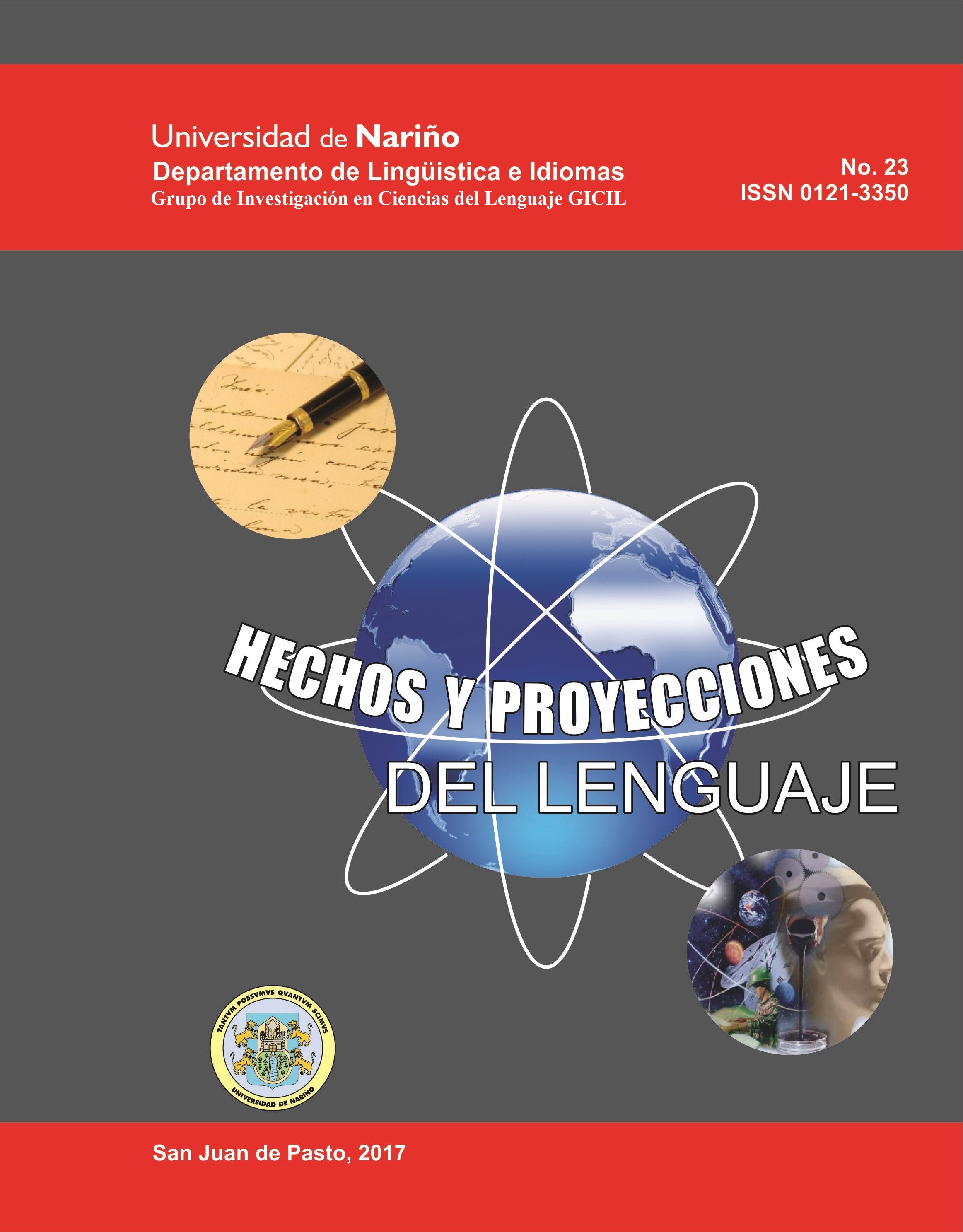Encuentros interculturales para la formación de futuros docentes de ELE: Un estudio de caso de telecolaboración intergeneracional.
Palabras clave:
español como lengua extranjera, telecolaboración, comunidades de aprendizaje, encuentros interculturales.Resumen
Las investigaciones acerca de la formación de docentes se han venido alimentado de teorías sociales del aprendizaje, tales como el aprendizaje situado (Lave & Wenger, 1991). Desde dichas perspectivas, el aprendizaje ya no se define como un proceso puramente cognitivo sino más bien como un proceso que se lleva a cabo en contextos específicos y que evoluciona a través de las interacciones y los aportes de los participantes. El presente estudio cualitativo describe la experiencia de tres profesores en formación que participaron en un proyecto de telecolaboración con hispanohablantes localizados en Colombia. Los datos se recolectaron a través de los mensajes de los participantes, entrevistas semi-estructuradas y el diario del investigador. Se efectuaron análisis interpretativo y de contenido. Los hallazgos resaltan la intrínseca relación entre práctica comunicativa genuina y el aprendizaje de lenguas y culturas extranjeras y enfatizan la dimensión social de los procesos de escritura. De igual modo los resultados describen escenarios telecolaborativos en los que los docentes en formación despliegan sus múltiples roles y se involucran en la práctica reflexiva acerca de su futuro profesional.Descargas
Citas
Allen, H., & Negueruela-Azarola, E. (2010). The professional development of future professors of foreign languages: Looking back, looking forward. The Modern Language Journal, 94(3), 377-395.
Barrett, M., Byram, M., Lázár, I., Mompoint-Gaillard, P., & Philippou, S. (2014). Developing intercultural competence through education. (J. Huber, & C. Reynolds, Eds.) Strasbourg: Council of Europe. [Online]. Consultado Octubre 22, 2017 en http://www.coe.int/t/dg4/education/pestalozzi/Source/Documentation/Pestalozzi3.pdf
Belz, J., & Kinginger, C. (2006). Discourse options and the development of pragmatic competence by classroom learners of German. The case of address form. Language Learning, 53, 591-647.
Borg, S. (2009). Language teacher cognition. En A. Burns, & J. Richards (Eds.), The Cambridge guide to second language teacher education (pp.136-171). Cambridge: Cambridge University Press.
Byrnes, H. (2001). Reconsidering graduate students’ education as teachers: “It takes a department!”. The Modern Language Journal, 85(4), 512-530.
Charron, N. (2007). “I learned that there’s a state called Victoria and he has six blue-tongued lizards!”. The
Reading Teacher, 60(8), 762-769.
Francomano, E. (2012). Graduate students in Spanish need to become humanities professors. Hispania, 95(3),
xviii-xix.
Franson, C. & Holliday, A. (2009). Social and cultural perspectives. En A. Burns, & J. Richards (Eds.), The Cambridge guide to second language teacher education (pp.40-46). Cambridge: Cambridge University Press.
Friedman, D. (2012). How to collect and analyse qualitative data. En A. Mckey, & S. Gass (Eds.), Research methods in second language acquisition: A practical guide (pp.180-200). Malden: Wiley-Blackwell.
Gómez, M. (2010, November). Improving students’ Intercultural Communicative Competence (ICC) through email activities. Articulo presentado en la 3a Conferencia de TICs para el aprendizaje de idiomas, Florencia, Italia. Consultado Octubre 22, 2017 en http://conference.pixelonline.net/ICT4LL2010/common/download/
Proceedings_pdf/ILT02-Gomez_Parra.pdf
Gousseva-Goodwin, J. V. (2000). Collaborative writing assignments and on-line discussions in an advanced ESL composition class. Unpublished doctoral dissertation. University of Arizona.
Greenfield, R. (2003). Collaborative e-mail exchange for teaching secondary ESL: A case study in Hong Kong. Language Learning & Technology, 7(1), 46-70.
Itakura, H. (2004). Changing cultural stereotypes through e-mail assisted foreign language learning. System, 32(1), 37-51.
Kern, R. (2006): Perspectives on technology in learning and teaching languages. TESOL Quarterly, 40(1), 183-210.
Kramsch, C. (1996). The cultural component of language teaching. Zeitschrift für Interkulturellen
Fremdsprachenunterricht, 1(2). [On line]. Consultado Octubre 22, 2017 en
http://www.collectionscanada.gc.ca/eppp-archive/100/201/300/zeitschrift/ 2002/02-05/archive/kramsch2.htm
Lave, J., & Wenger, E. (1991). Situated learning: Legitimate peripheral participation. Cambridge: Cambridge University Press.
Lázár, I. (2015). EFL learners’ intercultural competence development in an international web collaboration
project. The Language Learning Journal, 43(2), 208-221.
Liaw, M. (1998). Using electronic mail for English as a foreign language instruction. System, 26(3), 335-351.
Liaw, M. (2006). E-learning and the development of intercultural competence. Language learning & Technology, 10(3), 49-64. Consultado Octubre 22, 2017 en http://llt.msu.edu/vol10num3/liaw/
Liaw, M. & Johnson, R. J. (2001). E-mail writing as a cross-cultural learning experience. System, 29(2). 235-251.
Muller-Hartmann, A. (2006). Learning how to teach intercultural communicative competence via telecollaboration: A model for EFL teacher education. En J. Belz, & S. Thorne (Eds.), Internetmediated Intercultural foreign language education (pp.63-84). Boston, MA: Heinle & Heinle.
O'Dowd, R. (2003). Understanding the “other side”: Intercultural learning in a Spanish English e-mail exchange. Language Learning & Techonology, 7(2), 118-144.
O’Dowd, R. (2015). The competences of the telecollaborative teacher. The language Learning Journal, 43(2), 194-207.
O’Dowd, R. (2016, June). Telecollaborative exchange and its role in intercultural education. Articulo presentado en el seminario internacional de especialistas, Budapest.
O'Dowd, R., & Ritter, M. (2006). Understanding and working with ‘failed communication’ in telecollaboration exchanges. CALICO, 23, 1-20.
Schenker, T. (2012). Intercultural competence and cultural learning through telecollaboration. CALICO Journal, 29(3), 449-470.
Serrano, N. (2002). Teaching culture in foreign language programmes at third level education. CAUCE Revista de Filología y su Didáctica, 25, 121-145.
Summers, J., Beretvas, S., Svinicki, M., & Gorin, J. (2005). Evaluating collaborative learning and community. Journal of Experiential Education, 73(3), 165-188.
Ware, P., & Kramsch, C. (2005). Toward an intercultural stance: Teaching German and English through telecollaboration. The Modern Language Journal, 89(2), 190-205.
Wenger, E. (1998). Communities of practice: Learning, meaning and identity. Cambridge: Cambridge University Press.
Widdowson, H. G. (2003). Defining issues in English language teaching. Oxford: Oxford University Press.
Yang, S. C., & Chen, J. J. (2014). Fostering foreign language learning through technology-enhanced intercultural projects. Language Learning & Technology, 18(1), 57-75.


